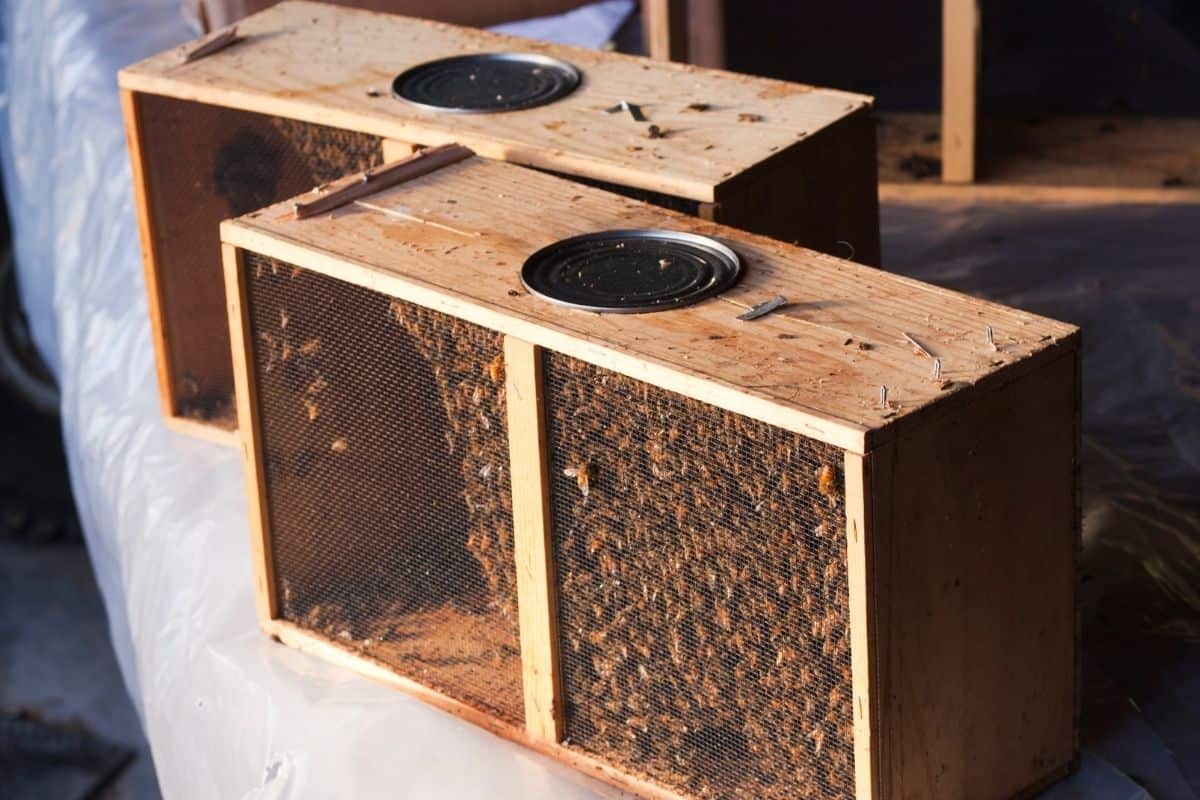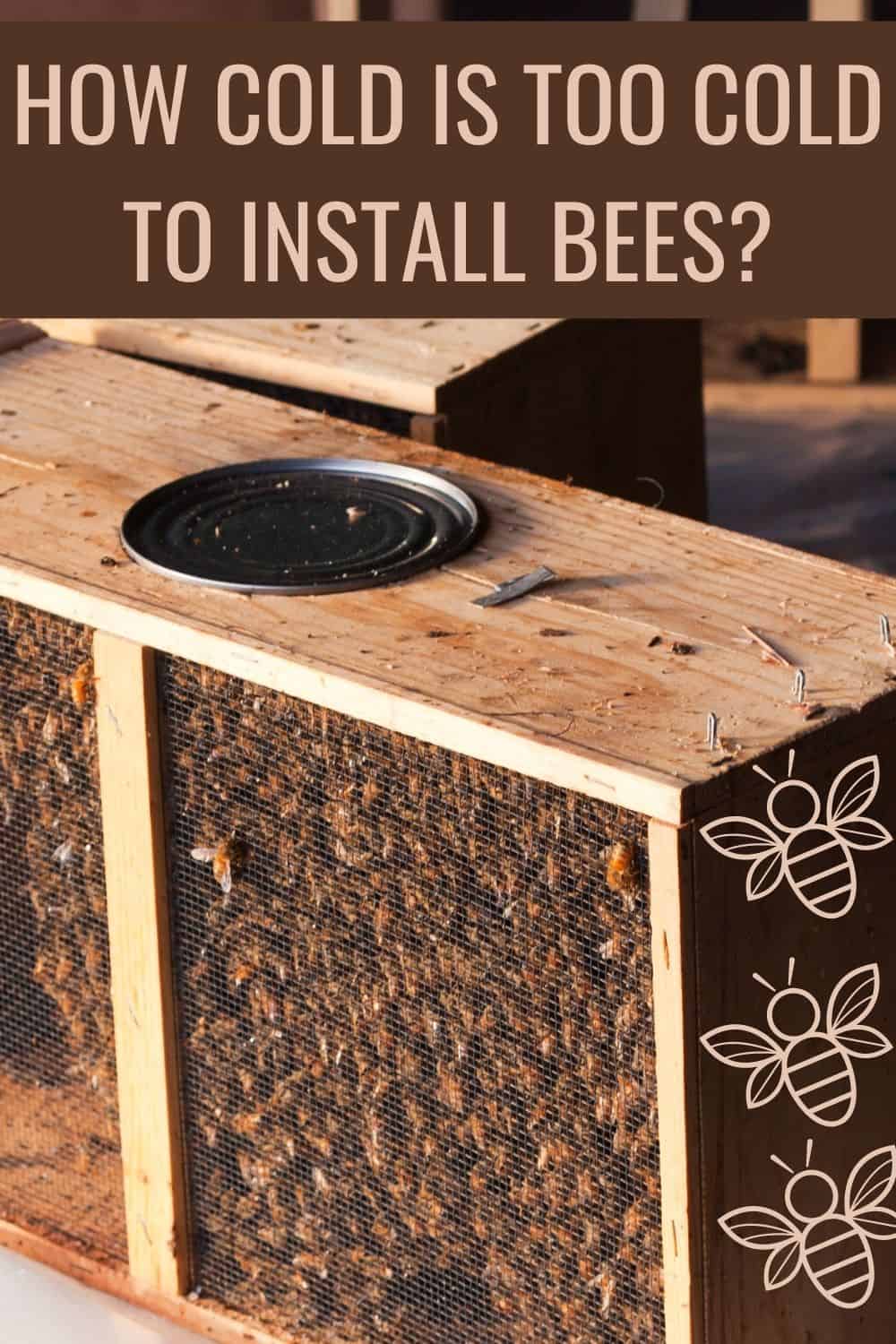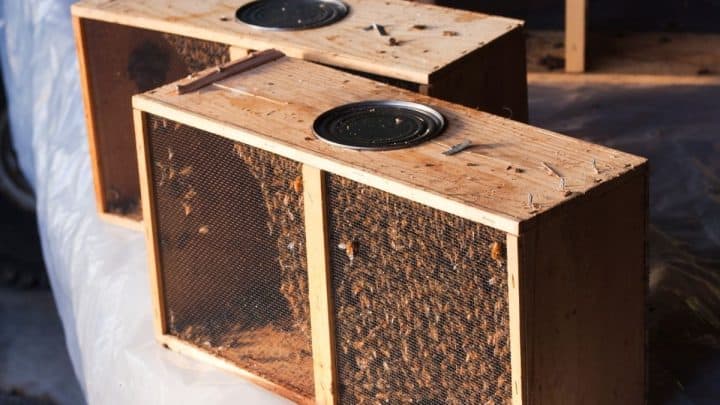Cold weather affects bees and their behavior, and if the weather gets too cold, it can be extremely detrimental to your bees, especially a new colony. Installing packaged bees in cooler weather can be an advantage, but if the temperature drops too low, the bees could suffer. So how cold is too cold to install bees?
The generally accepted lowest temperatures to install bees is not lower than 50-Fahrenheit. Bees will stop flying below 50-Fahrenheit and will cluster to keep warm. Bees can be installed in temperatures as low as 30-Fahrenheit, but different methods are required for the bees’ survival.

Beekeepers living in colder regions order their packaged bees to arrive in the early spring, but early spring weather can be unpredictable with sudden temperature drops and even snow falls. Bees will usually be warmer in a hive than in the package they were transported in, but the transfer method for temperatures below 50-Fahrenheit should be adjusted.
Can You Install Bees in Cold Temperatures?
Beekeepers in the northern parts of the United States have colder winters and a slower start to the spring than the southern regions.
Beekeepers may order their packaged bees early, hoping to get a jump on the season and get started as soon as possible. This strategy is not generally productive for northern beekeepers and could result in the bees struggling to survive when spring is late in arriving.
Have patience and order your bees later
Why wait to order your bees
Ordering your bees too early can have some undesirable results if your bees arrive and the temperatures in your region are below 50-Fahrenheit. Bees that arrive too early could struggle for the following reasons.
- They have come from a warmer region and are now in a suddenly cold environment with no forage available.
- More bees may die in transit during the transition from a warmer region to a cold region.
- Installing the bees in the hive will be more difficult and riskier.
- The bees will be in the hive unable to fly in the cold weather to forage for fuel to keep themselves warm.
- More time and effort will be required to feed the new bees and keep them warm.
Benefits of ordering your bees later
Having some patience and ordering your bees so that they arrive once spring is more established and the weather is warmer will have the following benefits.
- More of the bees will survive, giving you a stronger colony to work with that will grow quicker when the spring forage is available.
- The queen from the supplier would have had time to be better mated than too early in the season. A better-mated queen will produce more workers and not have to go out on a breeding flight soon after being installed.
- There will be available forage for your newly installed bees so they can fend for themselves quicker, which reduces the amount of work and stress for the beekeeper!
You’ll love this book: 100 plants to feed the bees
How does the cold affect bees?
When the temperature drops below 50-Fahrenheit, bees will not fly because the temperature is too cold for their muscles to operate correctly.
When the temperature drops below this point, the bees will cluster to trap the heat between their bodies. Bees on the outside of the cluster will be colder than the bees in the center of the cluster and will rotate their positions to try and keep the entire colony warm.
The queen will remain in the center of the cluster to ensure her survival and the survival of the colony. Some bees on the outside of the cluster may succumb to the cold and lose the ability to shiver and generate heat. These bees will drop off the cluster and fall to the bottom of the enclosure where they may or may not survive.
Bees need honey and pollen to provide protein and carbohydrates to fuel their bodies and give them enough energy to generate heat. In low temperatures, they cannot go out and forage for their food so they will need to rely on stored food in the hive.
Bees in a hive with brood will need to keep the internal hive temperature at 95-Fahrenheit to ensure the survival of the brood in the comb.
If the bees are packaged, they do not have brood and, thus, only need to maintain a temperature in the cluster of 68-Fahrenheit. Maintaining this lower temperature requires a lot less work from the bees.
Once the outside temperature warms up to 57-Fahrenheit or more, the bees will be able to leave the cluster and either forage for food or make use of a feeder supplying food from above the cluster.
Should you keep your bees in the package till the weather warms?
If you find yourself in the position where your packaged bees have arrived early and the weather is still cold outside, you may be tempted to keep them in the package until the weather improves.
You should not keep your bees in the package until warmer weather arrives. They have already been in the package for a few days in transit and keeping them in the package longer can be detrimental.
The bees will do better in a hive, but you will need to take some additional precautions when installing them in the hive.
- Place drawn comb in the hive. The drawn comb will keep the bees warmer because it will trap warm air in the hive.
- Place comb with honey on either side of the hive. Honey will not only give the bees food, but it acts as a natural insulator to keep retain the heat inside the hive.
- Install the bees in a warm room. Place the new hive in a room such as a garage or a shed that is warmer than the outside temperature. Give the hive time to warm up before installing the bees.
- Keep the bees quiet, warm and dark. After installing the bees keep them in the room with no lights on and the entrance of the hive blocked with mesh.
- Don’t heat the bees too much. Don’t let the hive get too warm. If the temperature in the room gets to 57-Fahrenheit the bees will become active and want to exit the hive.
- Feed your bees. The best location to feed your newly installed bees is from above so they do not need to leave the cluster to feed. You will need to feed them both sugar water and pollen substitute until the weather warms up enough for them to forage and the first spring flowers emerge.
Beekeepers who have used these methods have managed to install bees successfully in freezing temperatures of 30-Fahrenheit or lower with good success. Even though it is a lot more work to install bees in low temperatures, it is better for the bees to be in a hive than remain in the package for an extended period.
In conclusion, how cold is too cold to install bees?
The best strategy is to order your bees a little later to avoid the need to install bees in adverse weather. This will reduce the work and care needed to install the bees.
Installing bees in temperatures below the recommended 50 to 57-Fahrenheit can be done but it is not recommended for inexperienced beekeepers, since it requires much more monitoring, care, and knowledge to keep the bees alive.




Quick Introduction To Beekeeping
Thursday 10th of November 2022
[…] How Cold Is Too Cold to Install Bees? […]
What Time Of Day Is Best To Install Package Bees?
Sunday 21st of November 2021
[…] have an article dedicated to this topic called “How Cold is Too Cold To Install Bees?” which gives the details for installing bees in cold […]